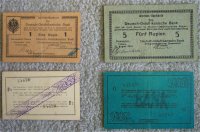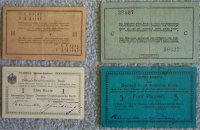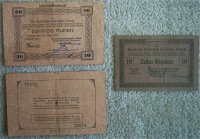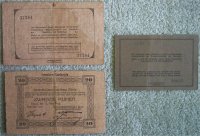One Rupee (EF Condition), issued 1st December 1915:Issued nearly a year to the day after the British Navy's battleship Goliath blocked the harbour at Dar-es-Salaam (page 69 "Duel for Mt Kilimanjaro" (see bottom of page) but before the British forces started their major launch to defeat the German forces under von Lettow Vorbeck. Five Rupee (Uncirculated Condition), issued 15th August 1915:Issued very early in the colonial war between the British and German forces. The book "Battle for the Bundu" (see bottom of page) records on page 42: "On August 15 (1915) Taveta (on the border of German East Africa and British East Africa to the north) fell to the three hundred Askaris of two Schutztruppe field companies, as the twenty four man garrison of the British East Africa police fired a token volley and retired in good order on Voi" - this was one of the German's few victories over the British during this extended campaign. |
One and Five Rupee, both Unc Condition and issued on 1st February 1916:When this note was issued the Germans still occupied a small portion of British East Africa around the district of Salaita. The book "Battle for the Bundu" records on page 145: "The British learned how solidly the Germans were dug in on 3rd February 1916 when they hit Salaita with a pounding artillery barrage that hurled many tons of dirt into the air but failed to budge the defenders an inch." Just two weeks later that famous South African General Jan Christian Smuts took command of allied forces in British East Africa. Smuts is determined to capture Vorbeck but fails. |




